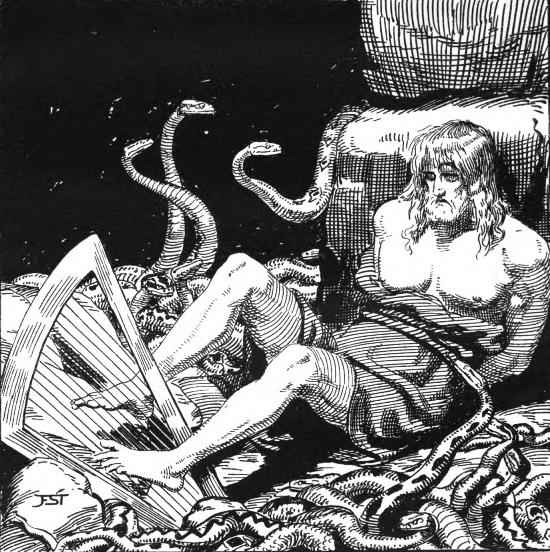1920
Franz Stassen
(1869-1949)

Illustrations for
Die Edda:
Germanische Götter- und Heldensagen
by Hans von Wolzogen
The Complete Mythic Illustrations
and a Sampling of the Heroic Illustrations
The Text Contains 48 Illustrations in All
Franz Stassen
(1869-1949)

Illustrations for
Die Edda:
Germanische Götter- und Heldensagen
by Hans von Wolzogen
The Complete Mythic Illustrations
and a Sampling of the Heroic Illustrations
The Text Contains 48 Illustrations in All
Franz Stassen (born February 12, 1869 in Hanau; died April 18, 1949 in Berlin), a German painter, draftsman and illustrator who first studied the Berlin Academy of Fine Arts from 1886 to 1892. He next settled in Hanau, but returned again to Berlin some time later. Stassen progressed from naturalism to Art Nouveau, in the style of Sascha Schneider, Fidus, Koloman Moser and Gustav Klimt. Stassen worked primarily as a book illustrator, illustrating more than 100 books, 50 bookplates and 25 postcard motifs. In 1908, he produced the Helden-Album, Stollwerck-Collector's Album No. 10, for Cologne chocolatier Ludwig Stollwerck. That same year he made contact with the Bayreuth Wagner circle, soon becoming an inside member. He created portfolios devoted to Wagner-works, including "Das Rheingold" and "Der Ring des Nibelungen". His style was partly realistic in form, influenced by the dramatic gestures and eye movements of the new popular medium cinematography. Contemporary publicists hailed Stassen's work as a tribute to Germanic nature worship and as the reform movement of the 20th century. Stassen himself connected his ideals with an esoteric and spiritualist Christianity. He joined the Nazi Party (NSDAP) in 1930, creating four tapestries for Hitler's Reich Chancellery, with motifs from the Eddas. He remained a politically neutral illustrator of Wagner's works, as well as myths and legends, headlining solo exhibitions in Bayreuth (1937) and Dresden (1940). In 1939, Hitler awarded him the honorary title "Professor". Stassen's wife Minna died in 1913, and after 1941 he lived with a male "significant other" attesting to his homosexual orientation. In 1944, near the end of the war, Adolf Hitler included him in a list of the most important Nazi painters. After the Second World War, Stassen went about with great energy repairing his war-damaged works. Up to his death in 1949, he was working on illustrations for Goethe's Faust. |
For more of Stassen's Work
on Germanic Myth and Legend, see also:
Rudolf Herzog's Die Nibelungen (1913)
Franz Stassen's Ring of the Nibelungen (1914)
Agnes Harder's Die Kinders Thor (1922)
[HOME]
[POPULAR RETELLINGS]
Rudolf Herzog's Die Nibelungen (1913)
Franz Stassen's Ring of the Nibelungen (1914)
Agnes Harder's Die Kinders Thor (1922)
[HOME]
[POPULAR RETELLINGS]
|
THE EDDA (1920) |
||
 |
||
 Frey and Gerda |
||
 Skirnir and the Shepherd |
||
 Skirnir and Gerd |
||
 Svipdag at the Gate |
||
 |
||
| Svipdag and Menglad | ||
 Slaying Kvasir |
||
 Odin Bores with Rati at Suttung's |
||
 Odin Drunk at Gunnlöd's "The heron of forgetfulness hovers over ale-gatherings and steals the wits of men: with that fowl's feathers I was once fettered within the court of Gunnlöd" (Hávamál 13, A. Orchard Translation) |
||
 Loki Arrives at Thrym's |
||
 The Gods Dress Thor as Freyja |
||
 Thor and Harbard |
||
 Odin and Frigg |
||
 Yggdrasil |
||
 Thor and Hymir Fishing |
||
 Loki's Punishment |
||
 Odin and the Völva |
||
 Odin Hanging on the World-Tree |
||
 Idunn falls from the World-Tree (Hrafnagaldr Óðinns) |
||
 Heimdall Blows the GjallarHorn |
||
 Baldur's Death |
||
 Nanna Grieves For Baldur |
||
 The Norns: Urd, Verdandi and Skuld with Mimir's Head |
||
 Odin and His Brothers Slay Ymir |
||
 The Battle of Ragnarök |
||
 Odin and His Brothers Create Ask and Embla |
||
|
THE HEROIC SAGAS The Text Contains Additional Illustrations from the Heroic Poems of the Edda. These are a Selection:  Völund the Smith |
||
 Völund Takes Flight |
||
 The Birth of Helgi Hundingsbane |
||
 Gunnar in the Snakepit |
||
 King Frodi's Mill |
||
 The Veil of Fate Lifted! |
||
|
Alternate Cover:  |
||
[POPULAR RETELLINGS]